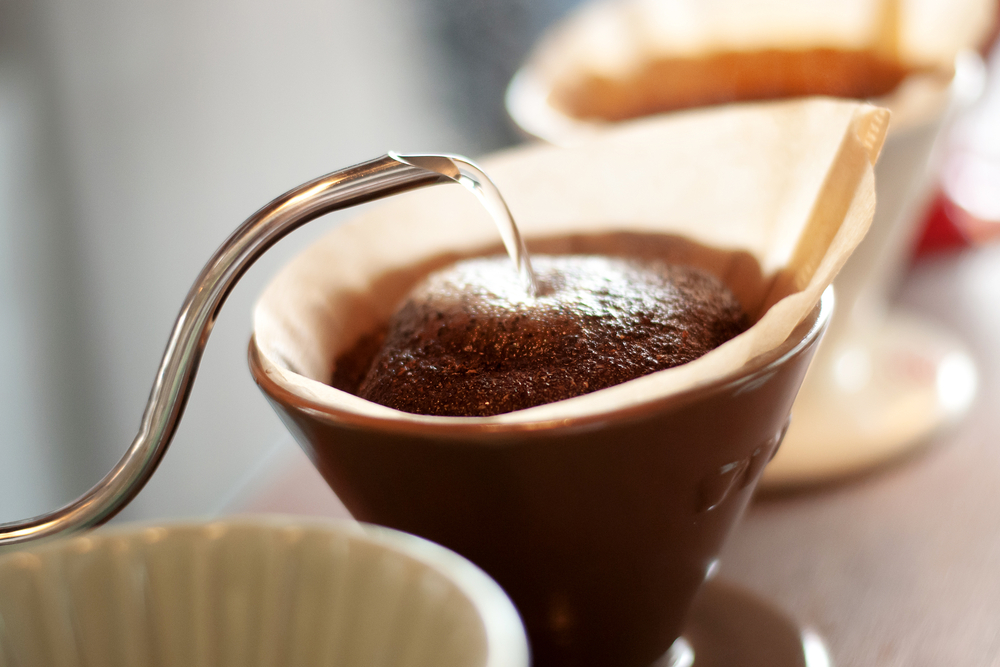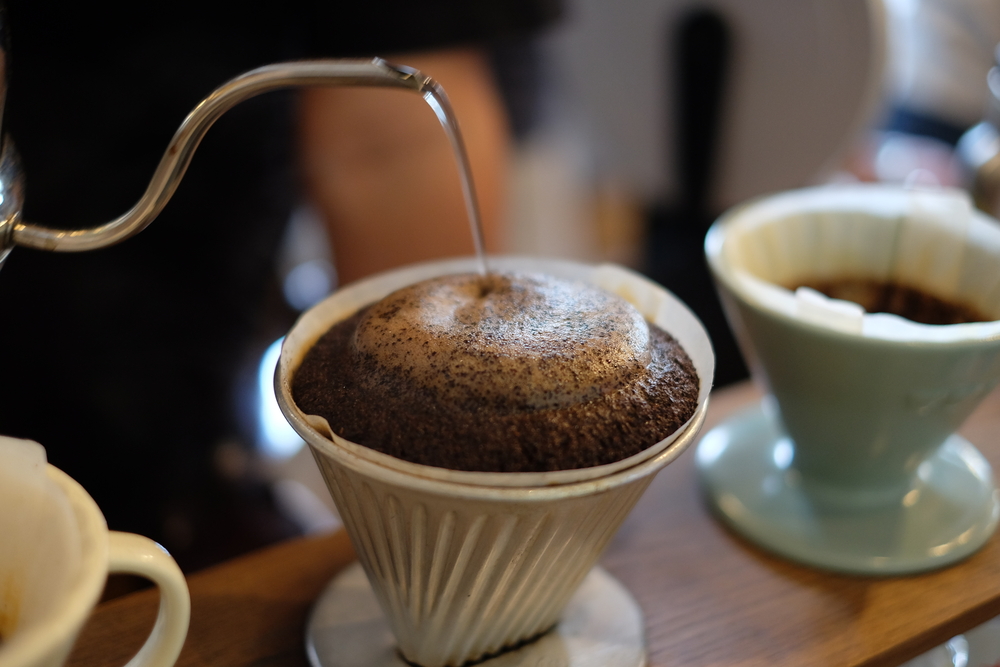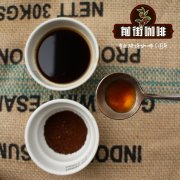There are thousands of filter cups, but what is the difficulty of making coffee by hand?
Professional coffee knowledge exchange more coffee bean information please follow the coffee workshop (Wechat official account cafe_style)
I don't know if you are like me, every time you see the online experts introduce the hand filter cup, how this filter cup tastes and how that filter cup should be made, you will sigh that hand brewing coffee is broad and profound, and you are never too old to learn.
But the more you learn about hand-brewing coffee and the more filter cups you collect, the more likely you are to have an annoyance. Think about it:
After breakfast on holiday morning, turn on the TV and get ready to watch a ball game. Time is still early in the pre-game analysis, even the national anthem has not been sung, you decided to have a cup of coffee. Choose the coffee beans to be slaughtered, cook the hot water, look at the filter cup "group", suddenly have a feeling of the emperor turning the brand, the mind flashed thousands of thoughts, tapered, fan-shaped or cake filter cup? Four or six, drip, triple break, quadruple break or constant water? 88, 90, 92 or 93 °C? Cone knife or flat knife? Is the scale 2.5 or 3? After thinking about it, I stared at the clock and said that I was ready to change to a large current to raise the water level and concentrate on the second minute and 37 seconds. The TV unexpectedly said, "the goal is scored!" The goal is scored! "you are so angry that you don't know whether to rush back to watch the replay or continue to finish this cup of coffee with tears in your eyes.
When you see here, you will say that this is not yet home, and the experience is still not enough to translate into intuition. Maybe, but to be honest, if one kind of filter cup needs one kind of punching method and one kind of baking degree also needs one kind of punching method, can we finish the practice? We often find it difficult to make coffee by hand. the problem is not to make a cup of coffee that tastes good, but to make good coffee with different filter cups and beans. Or, we can disassemble it first, where is the difficulty of hand flushing?

The process of brewing coffee by hand is just doing one thing: dissolve in the filter cup, and then let the solution out of the filter cup. The congenital limitation of the filter cup is very large, the flow rate is too fast, the contact time between water and coffee is not enough, the dissolution efficiency in the filter cup is low, and the drink is very light; the flow rate is not fast enough, and the concentration of the solution in the filter cup is too high, which means that the solvent is not fresh enough and the extraction power is also decreased. However, the flow rate should be controlled by people, not by it. People will be lazy, professional stores will rarely change the grinding degree of hand, players are even lazier, many people have played Pegasus 3.5 all their lives. The constant degree of grinding meets different filter cups and different beans, and the difference in flow rate appears.
To put it simply, the fundamental problem of cooking with different filter cups and beans is to control the "flow rate".
Most people use the degree of grinding to control the flow rate, and the degree of grinding directly affects the concentration of TDS. We normal people have a fixed range of preferences for concentration, and even if we are loyal fans of boutique coffee, the preference of TDS almost falls between 1.3 and 1.7 percent. Too high or too low concentrations can weaken our ability to distinguish taste. In other words, usually we don't want to change the final TDS of coffee too much, so we will fix the grinding thickness to make sure we get a fixed TDs. This statement sounds correct, but it only exists in the ideal state and can hardly reach the ideal, so it is specious. Because what you want to drink is outside the filter cup, not inside the filter cup. The fact that we achieve the best concentration An in the filter cup does not mean that we also get the concentration An after passing through the filter cup. The components that have been dissolved in the filter cup will cause the concentration to decrease because we cannot pass through the filter cup or there is no time to cross it. The ingredients are also screened.
According to the concept of gold cup, the weight of coffee liquid x TDS/ dry powder = the extraction rate, the larger the molecule in the formula, the higher the concentration of TDS, or the more coffee is obtained, the extraction rate will increase. The larger the denominator in the formula, that is, the more powder is used, the extraction rate will decrease. If the target is TDS 1.3 extraction rate of 20%, to get a cup of 230g coffee liquid, you need 15g coffee powder. So how to make the TDS reach 1.3 when the extraction rate is 20%? This needs to adjust the grinding degree and water temperature and other parameters.
But our daily cooking certainly will not have the kind of equipment to display TDS readings immediately, even after cooking, not everyone may have the conditions to test the concentration, how to test TDS and extraction rate? There is a way, the poor have their own poor hand play-drink, appropriate to your taste of the concentration and extraction, naturally hit the bull's-eye of the gold cup extraction. So we often emphasize that we should learn to taste before we learn to cook, and we often tell you not to care too much about the golden cup. If you can't tell the difference between TDS 1.3 and TDS 1.2, what does the golden cup mean to you?
The second biggest factor affecting the flow rate is coffee beans. Coffee beans also have essential differences because of different roasting, internal and external inhomogeneity is a kind of difference, water absorption efficiency is a kind of difference, and the type after grinding is a kind of difference, which directly affect the dissolution efficiency. The shallower the baking is, the worse the dissolution efficiency is. What we have to worry about is the decline of the extraction rate. When you see a decline in the extraction rate, I'm afraid you first think of grinding it a little bit, but in one case, after grinding, the flow rate is so slow that there is no time for water to accumulate in the filter cup, and a cup of coffee is still dripping after four or five minutes. This is especially common on single-hole fan-shaped filter cups. Dripping slowly should increase the extraction rate, not necessarily. At this time, some of the unUnited fine powder will find its own gap, the lower the powder layer is stronger and stronger, blocking the outlet of the filter cup is unbreakable. The water in the filter cup can only slip through the filter paper from the upper edge and does not come into contact with the coffee powder in the middle of the powder layer.
In another case, the powder is fine but the flow rate is normal. Coarse particles go their own way, and small particles have a chance to unite. When fine particles attract each other, the powder layer in that part is closer than in other places, resulting in a larger gap between coarse particles and coarse particles, and the current can bully this weak area more easily. In this case, our eyes see that the speed at which coffee flows into the next pot is an illusion, using the term espresso is a huge and out-of-control "perforation". If you don't believe it, you can measure TDS. If you grind fine and flow fast, there is a good chance that TDS will fall instead of rising. It is possible to fall below 1.
You see, the degree of grinding sometimes doesn't work well, and the flow rate can't be controlled at all.
There is also a secret weapon-a spoon that is stirred in the filter cup from time to time to make the coffee powder have an equal chance of absorbing water, or to dig up the silt when the flow rate drops sharply. Um... This operation looks very low, not elegant at all, but do you have the ability to control water injection as evenly as a spoon? Don't answer too quickly, don't talk about you, many masters can't do half the efficiency of a spoon.
If you stop focusing on the brewer's focused expression, ceremonial movements, and MLM eloquence, and just think of yourself as that pile of coffee powder, hand-brewing coffee just looks amazing. Think of yourself as a junior high school student, recall that when I did the experiment for the first time, I saw it with my eyes, read it again and again with what was written in the textbook, organized the basic concepts, and then went back to this method of boiling flowers on coffee powder with hot water. Naturally, I don't feel surprised. Before we start to find teachers to pay tuition fees, before we start ten years of water control practice, we might as well think about what hand flushing is all about. Everyone is talking about the flow rate of the filter cup. What meaning does the flow rate convey to us?
END
Important Notice :
前街咖啡 FrontStreet Coffee has moved to new addredd:
FrontStreet Coffee Address: 315,Donghua East Road,GuangZhou
Tel:020 38364473
- Prev

Five tips for making delicious coffee! How to flush out the coffee that most people agree with?
Professional coffee knowledge exchange more coffee bean information Please pay attention to the coffee workshop (Wechat official account cafe_style) generally people's acceptance of coffee taste is very subjective, a few people ask for high-quality and delicious coffee, but most people's request may just not be bad. The same cup of coffee will have unlimited feelings due to the taste of different people. Generally speaking, there are some ways to
- Next

What are the main treatment methods of raw coffee beans? how to distinguish the grades of raw coffee beans?
Professional coffee knowledge exchange more coffee bean information please pay attention to the coffee workshop (Wechat official account cafe_style) Coffee Cherry is actually a kind of fruit, coffee bean is the cultivation of coffee cherry, and then through different treatment methods to give coffee raw beans different flavor, after baking can enlarge the flavor of this treatment, thus forming different flavors and mouths of different coffee
Related
- Beginners will see the "Coffee pull flower" guide!
- What is the difference between ice blog purified milk and ordinary milk coffee?
- Why is the Philippines the largest producer of crops in Liberia?
- For coffee extraction, should the fine powder be retained?
- How does extracted espresso fill pressed powder? How much strength does it take to press the powder?
- How to make jasmine cold extract coffee? Is the jasmine + latte good?
- Will this little toy really make the coffee taste better? How does Lily Drip affect coffee extraction?
- Will the action of slapping the filter cup also affect coffee extraction?
- What's the difference between powder-to-water ratio and powder-to-liquid ratio?
- What is the Ethiopian local species? What does it have to do with Heirloom native species?

